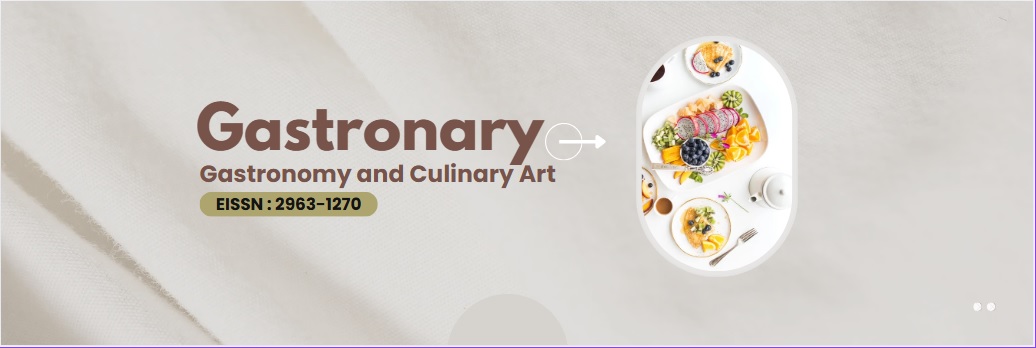Innovation of Red Bean Flour as A Substitution for Wheat Flour in Making Noodle
DOI:
https://doi.org/10.36276/gastronomyandculinaryart.v2i2.515Keywords:
Red Bean Flour, Wheat Flour, NoodleAbstract
Red bean flour is a type of legume that has many benefits for the body, it's just that its use is not optimal. In this experiment, the researchers innovated noodles by changing the main ingredient with red bean flour. This study aims to find out, 1) How to properly process red bean flour in processed red bean noodles. 2) Can red bean flour be used as a substitute for wheat flour in making noodles. 3) How is the consumer response to aspects of taste, color, texture and aroma of red bean flour noodles. Data collection methods used by researchers are questionnaires, literature studies, and interviews. The test method in this study uses organoleptic testing and the data obtained will have problems in the frequency distribution of the data. The results showed that the cooking methods and procedures for red bean flour noodles and wheat flour noodles had differences. This difference is based on processing methods and processing procedures. The first experiment required an additional ingredient as an adhesive, the second experiment had good results but required an adhesive other than wheat flour, the third experiment required an unsuitable adhesive material, the fourth experiment required the addition of the composition of the ingredients, changes in cooking methods and procedures. The fifth experiment of noodles produced was good and fulfilled standard noodles in general. Based on the results of organoleptic testing of noodles in this study, the taste assessment of wheat flour noodles has a rating of 3.1. while the taste assessment of red bean flour noodles was 3. The assessment of the color aspect of wheat flour noodles had a rating of 2.9. while the color assessment of red bean flour noodles was 2.6. Assessment of the texture aspect of wheat flour noodles has a rating of 2.9. while the texture assessment of red bean flour noodles was 2.8. Assessment of the aroma aspect of wheat flour noodles has a rating of 2.9. while the aroma rating of red bean flour noodles is 3. From the assessment above, in terms of quality, the aspects of taste, color, aroma, texture of red flour noodles are the same as wheat flour noodles.
References
Astawan, M. 2009. Sehat Dengan Hidangan Kacang dan Biji-Bijian. Penebar Swadaya. Jakarta.
Ayu Eka Laksmi Dewi, A. A. (2020). Pengaruh Penambahan Labu Kuning (Cucurbita Moschata) Terhadap Mutu Organoleptik, Kapasitas Antioksidan Dan Nilai Gizi Mie Basah (Doctoral dissertation, Poltekkes Denpasar). http://repository.poltekkes-denpasar.ac.id/4001/
Badan Pusat Statistik. 1999-2018. Statistik Indonesia (Statistical Year Book of Indonesia). Jakarta: BPS. https://www.bps.go.id/publication/2018/07/03/5a963c1ea9b0fed6497d0845/statistik-indonesia-2018 diakses pada 24 maret 2023
Fadhilah, S. C. H. (2021). Variasi Pencampuran Tepung Kacang Merah Terhadap Karakteristik Fisik, Organoleptik Dan Kadar Serat Pangan Pada Kaasstengels (Doctoral dissertation, Poltekkes Kemenkes Yogyakarta). http://eprints.poltekkesjogja.ac.id/3381/
Haumahu, C. P., & Wenno, Y. H. (2021). Intervensi Team Building Training Untuk Meningkatkan Kualitas Koordinasi Dalam Teamwork. Jurnal Pendidikan Ekonomi (Jpe), 1(2), 58-64. https://doi.org/10.30598/jpe.v1.i2.p58-64
Ilahiyyah, I., Mulyati, S., Ningsih, I. S., Nindhita, L. N., & Sari, R. R. (2017). Tahu Nikah (Nigari Kacang Merah) Sebagai Bentuk Diversifikasi Makanan Sehat Ramah Lingkungan. Journal of Creativity Student, 2(1), 26-33. https://doi.org/10.15294/jcs.v2i1.10727
Lestari, S., & Susilawati, P. N. (2015). Uji organoleptik mi basah berbahan dasar tepung talas beneng (Xantoshoma undipes) untuk meningkatkan nilai tambah bahan pangan lokal Banten. Pros Sem Nas Masy Biodiv Indon, 1(4), 941-946. DOI: http://dx.doi.org/10.13057/psnmbi/m010451
Mustofa, A., & Widanti, Y. A. (2017). Karakteristik kimiawi mie kering dengan substitusi tepung kacang merah (phaseolus vulgaris l.) dan ekstrak bit (Beta vulgaris L) dengan berbagai perlakuan pendahuluan. Sagu, 16(2), 10-16. https://sagu.ejournal.unri.ac.id/index.php/JSG/article/download/5404/5049
Sugiyono. (2013). Metodologi Penelitian Kuantitatif, Kualitatif Dan R&D.
Sugiyono. (2014). Statistika untuk penelitian. Bandung: Alfabeta
Downloads
Published
How to Cite
License
Copyright (c) 2023 Tessa Yulia Hilda Rahmawati, Budi Hermawan, I Made Witara, Gunawan Yuliyanto, Setyo Prasiyono Nugroho

This work is licensed under a Creative Commons Attribution-ShareAlike 4.0 International License.






